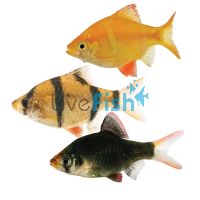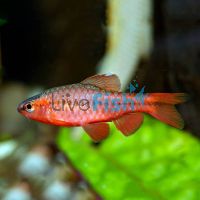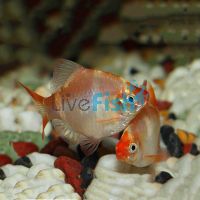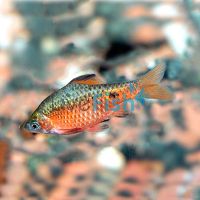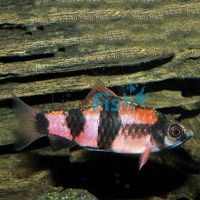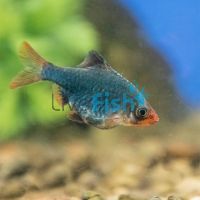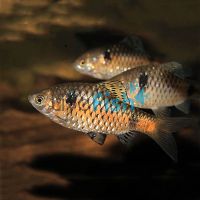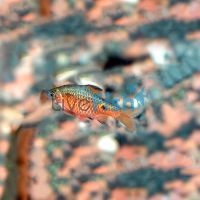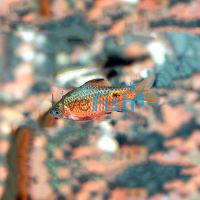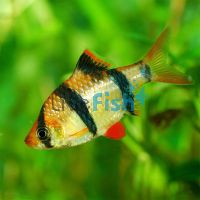Barb Care
Barbs are members of the Cyprinidae family and are a widely available species of freshwater aquarium fish. They are often a popular choice for people’s first pet fish. An appealing feature of these fish is that they are constantly active in your aquarium.
They generally have a reputation as being aggressive towards other fish, but this isn’t true for all varieties of Barb. Even the more aggressive types make great additions to an aquarium when kept in the right environment.
These fish are a naturally schooling species and so keeping them in a group of at least five is recommended. They look great schooling especially in medium to larger fish tanks.
The most popular barbs you will come across for home aquariums are the smaller species. Varieties that include the Rosie Barb, Tiger Barb, Cherry Barb, Black Ruby Barb and Gold Barb, we have these and more.
Natural Habitat

The Barb family is very large with members found in Europe and Africa as well as Asia. Most of the varieties that we stock are the smaller varieties being from the South East Asia region.
Most commonly they are found in slow-moving rivers and streams, but some species can also be found in other water systems like lakes and swamps.
Behavior/Compatibility for Barbs
Barbs do have a reputation for being fin nippers, which is true for some species like Tiger barbs and Rosie barbs. However, some species are peaceful and make excellent community tank members.
Some of the more aggressive types such as Tiger Barbs shouldn’t be kept with slower moving long finned or smaller species such as guppies or betta fish. They need to be kept with more robust tankmates. Less aggressive varieties like Gold and Cherry Barbs will mix with more tankmates.
With larger species of Barb small fish varieties need to be avoided as they are opportunistic feeders. Which means that they will eat pretty much anything that fits into their mouths.
Larger Tetras and Rasboras, Gouramis, other Barbs, Rainbowfish and Corydoras, are all suitable tank mates.
Keep them in a larger school of 6 or more and they will be less aggressive and this helps with fin nipping tendencies on their tankmates.
Don’t keep them with larger Cichlids like Oscars that can fit them in their mouths as they will view them as a meal.
Housing Barbs and Tank Set-up Tips
Tank
Barbs do vary in size quite considerably with some being quite small like the Cherry Barb that grows to 5cm (2 inches). Whilst other varieties grow significantly larger like the Tinfoil Barb that can reach up to 35cm (14 inches). Barbs are active swimmers and so need a tank with space.
The below stocking recommendations are based on Rosy Barbs which can actually grow to bigger than many people think. This is usually because when see them in pet shops they will still be young and so still fairly small. A fully grown Rosy Barb can get as big as 14cm (6 inches).
Recommended Max Fish Count Tank Volume 2 Rosy Barbs 38 litres (10 gallons) 4 Rosy Barbs 76 litres (20 gallons) 7 Rosy Barbs 114 litres (30 gallons) 11 Rosy Barbs 151 litres (40 gallons) 13 Rosy Barbs 189 litres (50 gallons) Base
Barbs are generally mid-water swimmers. A fine-to-medium grade substrate is usually suitable for them, but isn’t essential.
Foliage
Barbs do like a well planted tank and they will eat plant matter as part of their diet. They do also need space to swim too so ensure that there are still open spaces.
We have a selection of different aquarium plants and fish tank decorations available for your tank that you can get delivered at the same time as your fish.
Water
Barbs are fairly hardy and can handle a few different water temperatures. You should keep the temperature between 23.9° - 26.7° C (75° - 80° F) with a pH range of 6.8 - 7.8 and the hardness should be between 3° - 8° dKH (50 - 140 ppm).
You should ensure there is good filtration, and we recommend a 10% water change each week or a 25% change every other week. Using a vacuum gravel cleaner regularly is recommended to remove waste from your substrate. When performing water changes with tap water don’t forget to treat the water with a water conditioning products like Easy Balance Plus before you add it to your aquarium.
Feeding and Care
Barbs are mostly omnivorous, they'll accept a broad range of flake foods and small pellets in the aquarium. Feeding them live food as a treat will also be welcomed and you should feed them once or twice a day with no more food than they consume in 2 minutes.
Barbs will eat a range of live foods including bloodworm, brine shrimp, daphnia, and various small insects and crustaceans. Being omnivores, having algae wafers or plants in the tank they can nibble on is a good idea. We have a wide selection of fish foods available including flake, live and freeze dried foods that you can order for delivery to your home.
Great reasons to keep Barbs in your tropical fish tanks
- A school of Barbs in your tropical fish tank will make your aquarium a centerpiece wherever you have it.
- There's many different species, with different colours and sizes for you to choose from.
- These fish certainly live up to the tag 'live colour in motion', bringing your tank to life.
View the different Barb varieties we have ready for you now, order your aquarium fish online and we'll get them delivered right to your home.


